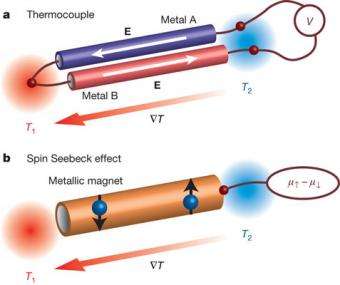October 10, 2008 weblog
New spintronics effect could lead to magnetic batteries

(PhysOrg.com) -- Physicists have recently discovered that heating one side of a magnetized nickel-iron rod causes electrons to rearrange themselves according to their spins. This so-called "spin Seebeck effect" could lead to batteries that generate magnetic currents, rather than electric currents. A source of magnetic currents could be especially useful for the development of spintronics devices, which use magnetic currents in order to reduce overheating in computer chips, since, unlike electric currents, magnetic currents don´t generate heat.
Physicist Eiji Saitoh of Keio University in Yokohama, Japan, and colleagues from other Japanese institutions have published their results in a recent issue of Nature. As they explain, the term "spin Seebeck effect" comes from the original Seebeck effect, a thermoelectric phenomenon discovered by Thomas Johann Seebeck in the 1800s. In the Seebeck effect, heating one side of a conducting rod causes electrons at that end to heat up and move toward the cooler side, creating a voltage.
The spin Seebeck effect is similar, but affects electron spin, which is the quantum physics equivalent of north-south magnetic alignment. When heating a magnetized metal, such as the nickel-iron rod, the researchers found that electrons with up spins (aligned with the rod´s magnetic field) congregated on the warmer side, while electrons with down spins (unaligned) preferred the cooler side.
Essentially, this spin-segregated rod now has two electrodes and serves as the basis for a new kind of battery that produces "spin voltage," or magnetic currents, which have been difficult to produce. With this tool, physicists can work toward developing more kinds of spintronics devices that store information magnetically.
Magnetic information storage is inherently more efficient than storing information electronically because there is no waste heat. Unlike electrons that constantly bump into each other, flipping electron spins doesn´t generate heat. Reducing waste heat could lead to computer chip miniaturization, and would also mean lower power consumption and faster operational speeds.
"The spin Seebeck effect allows us to pass a pure spin current, a flow of electron spins without electric currents, over a long distance," the authors wrote in their study. "These innovative capabilities will invigorate spintronics research."
More information: Nature study
via: Science News




















